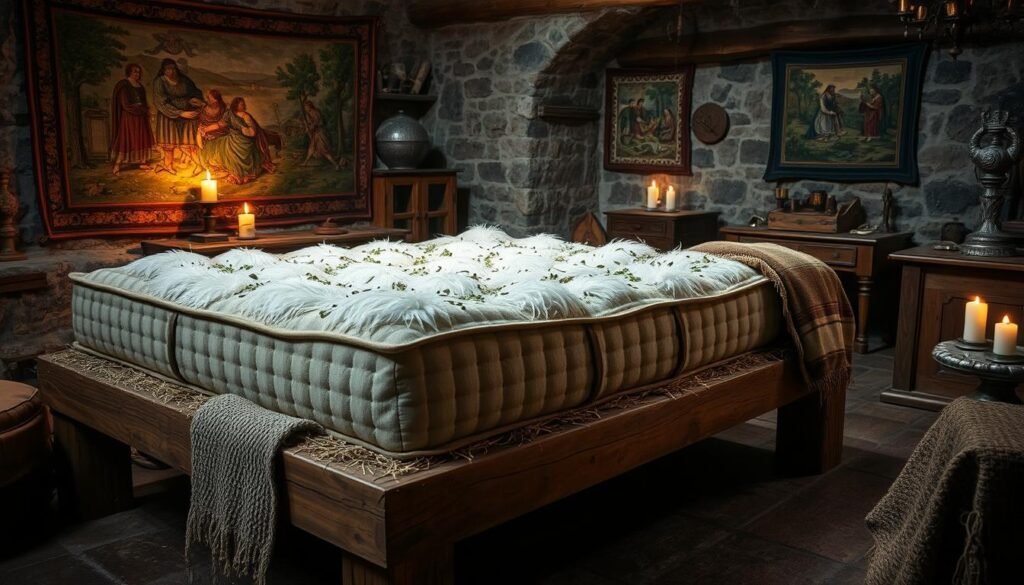Imagine going back to the 14th century. The rich had grand beds with fancy canopies and embroidered hangings. It was a sign of their wealth1. But, most people had simple straw mattresses on the floor. They used whatever they could find to stay warm2.
By the 15th century, even middle-class families started getting featherbeds and bolsters. This showed a slight improvement in their sleep1.
The most luxurious beds had canvas mattresses filled with wool or straw. They were topped with featherbeds, bolsters, and soft linen. Some even had fur or silk linings to show off the owner’s status1. Bedding materials varied, from fine Rennes linen to coarse hemp. The most expensive coverlets were made of silk like samite, damask, and sendal1.
Key Takeaways
- In the 14th century, the wealthiest households had large and elaborate beds with ornamented canopies and richly embroidered hangings.
- Middle-class families in the 15th century began acquiring more comfortable bedding, such as feather beds and soft sheets.
- The best beds in the medieval era featured canvas mattresses filled with wool or straw, topped with featherbeds, bolsters, linen sheets, blankets, and coverlets.
- Bedding materials ranged from the finest Rennes linen to coarse hemp, and luxurious silk varieties.
- Peasants slept on simple straw mattresses on the floor, while the elite enjoyed lavish sleeping quarters.
Sleeping Arrangements in Medieval Times
In the Middle Ages, how people slept changed based on their social status and wealth. The rich had fancy beds with canopies and curtains for warmth and privacy3. Their beds had canvas mattresses filled with wool or down feathers3.
Beds of the Nobility and Wealthy
The nobility and aristocracy had the most luxurious beds. These beds were four-poster with wooden frames and ropes, filled with feathers or down3. Beds were not just for sleeping; they were also places for social gatherings3.
Merchants and artisans had wooden bedsteads with simple headboards and feather mattresses4. Peasants and the very poor slept on straw, wool, and feathers, which they could roll up during the day4.
Sleeping in medieval times was hard, with little privacy and no control over temperature3. Castles were cold, drafty, and smoky. People used tapestries, furs, and heated rocks to stay warm3. The floors were dirty, with rushes that harbored fleas and lice3.
Despite these issues, many preferred sleeping on a trestle table in the great hall3.
As time went on, beds became more common. People slept in two parts, known as first and second sleep5. By the 17th century, beds were a big deal for families, costing a quarter of their household’s value5.
what were mattresses made of in the 1300s
In the 1300s, mattresses were made from various natural materials. This showed a person’s wealth and status6. Peasants slept on mattresses filled with straw or wool6. On the other hand, the rich enjoyed fancy beds with canopies and curtains6.
The poorest people had a simple straw mattress on the floor6. But, the rich had mattresses filled with feathers. This was a sign of their high status6.
The middle class in the 14th century had mattresses filled with wool or flock6. These woolen mattresses were so valuable, they were left in wills6. The rich added a featherbed on top for extra comfort6.
| Mattress Filling | Social Class |
|---|---|
| Straw or wool | Peasants |
| Feathers | Nobility and wealthy |
| Wool or flock | Middle-class |
The most luxurious beds had canvas mattresses filled with wool and straw6. This made a soft and supportive bed for the rich6.

“Mattresses in the Middle Ages were a reflection of one’s social status and wealth, with the poorest sleeping on straw and the elite enjoying the luxury of feathers.”
The variety of materials used for mattresses shows the big differences in living conditions back then7. From straw beds for peasants to feather mattresses for nobles, the 1300s mattresses showed the social hierarchy6.
Conclusion
The8 medieval bedding materials and mattress compositions in the 1300s showed the social and economic status of their owners. The poorest slept on straw mattresses on the floor. But, the nobility and wealthy had fancy, canopied beds with featherbeds8.
Middle-class homes used mattresses filled with wool or flock. This showed the variety of sleeping options back then.
The materials for medieval mattresses, like straw to feathers9, tell us about the evolution of sleep habits. They highlight the bed’s role in daily life in the 14th century. From Sumerian beds with wooden frames and precious metal inlays to the beds of medieval England, the history of bedding shows how attitudes and practices changed over time.
Knowing the8 value placed on beds and bedding in the late medieval period is key. It also helps us understand the9 range of materials and techniques used in ancient Mesopotamia and medieval Europe. This lets us see the rich history of mattresses in the 1300s and how bedding materials shaped life and status89.
FAQ
What were mattresses made of in the 1300s?
What were the sleeping arrangements like in medieval times?
What materials were used to make medieval mattresses?
Source Links
- Beds in late Medieval and Elizabethan England – http://www.oldandinteresting.com/medieval-renaissance-beds.aspx
- Medieval Beds: Two Examples from 1488 – Medievalists.net – https://www.medievalists.net/2023/08/medieval-beds/
- medieval castle sleeping arrangements – History Undressed – https://historyundressed.wordpress.com/category/medieval-castle-sleeping-arrangements/
- Sleep in the Middle Ages – https://stores.renstore.com/history-and-traditions/sleep-in-the-middle-ages
- A Closer Look at Sleep Habits We’ve Left Behind – https://www.architecturaldigest.com/story/sleep-habits-history
- A short history of the bed – Beck’s Bedding – https://www.becksbedding.com.au/bedroom-design/a-short-history-of-the-bed/
- What is the History of Bedding and Mattresses? – https://nobullmattress.com/bedding-history/?srsltid=AfmBOoqI3lu4wGC3TM3usJSaaiPeTcbUwqk5HuGGGaB-f9C7VuUx-45g
- The Scene of Life and Death in Late Medieval England – https://quod.lib.umich.edu/f/frag/9772151.0005.003/–honest-bed-the-scene-of-life-and-death-in-late-medieval?rgn=main;view=fulltext
- Ancient furniture – https://en.wikipedia.org/wiki/Ancient_furniture
